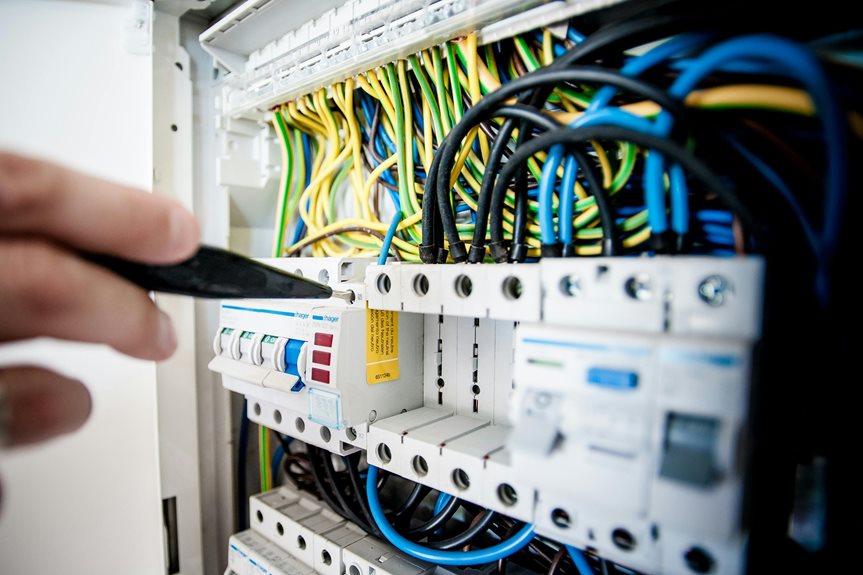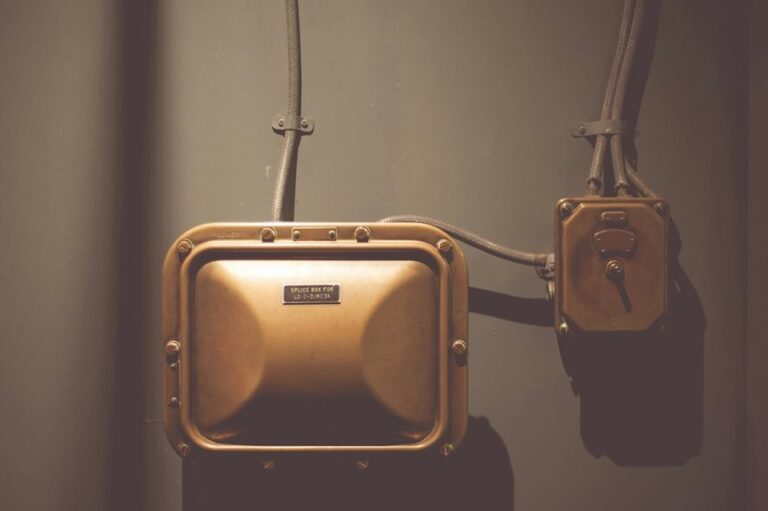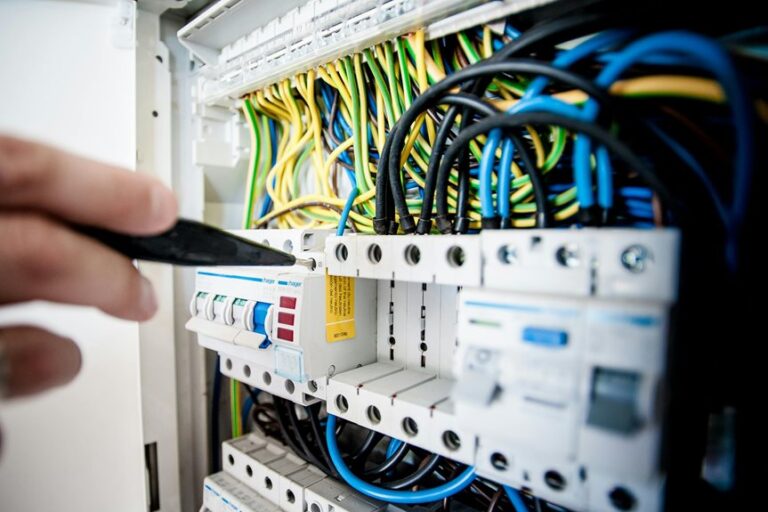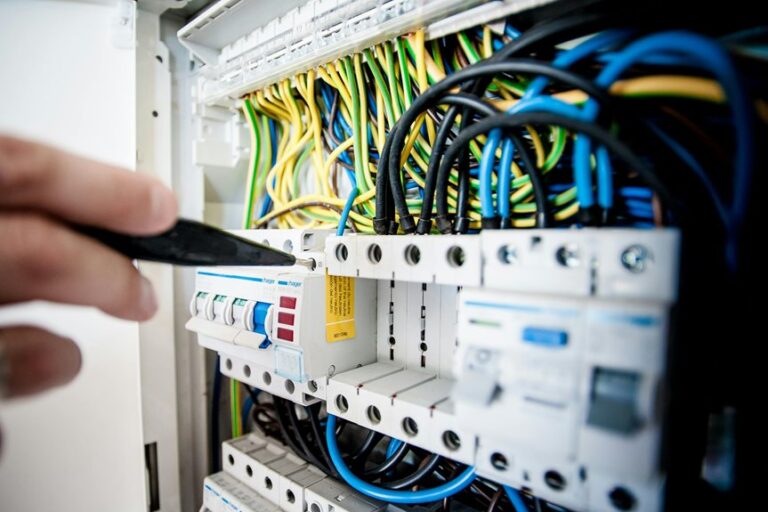You might think you can handle minor electrical issues on your own, but certain signs indicate it's time to call an electrical professional. If you're experiencing frequent circuit breaker trips, flickering lights, or strange odors coming from outlets, these aren't just annoyances; they're potential safety hazards. Ignoring them can lead to more severe problems, including fire risks. Understanding the specific symptoms that require expert intervention is essential. What should you look for next, and how can addressing these issues proactively save you from larger headaches down the line?
Frequent Circuit Breaker Trips
If you notice your circuit breaker tripping frequently, it's important to address the issue promptly. Frequent trips can indicate underlying electrical problems that may pose a safety hazard.
First, consider whether you're overloading the circuit. Each circuit has a specific amperage limit; exceeding this can cause the breaker to trip. Check the total wattage of the devices plugged into the affected circuit to verify it doesn't exceed the breaker's capacity.
Next, inspect for faulty wiring or connections. Damaged wires can create short circuits, leading to frequent trips. Look for signs of wear, such as frayed insulation or scorch marks.
Additionally, consider the age of your breaker. Older breakers may be more prone to malfunctions and could require replacement.
If you find no obvious issues, it's prudent to consult a licensed electrician. They can perform a thorough inspection and diagnose problems that may not be visible. In fact, many of the top electricians in San Bernardino can help you ensure your system is up to code.
Ignoring frequent circuit breaker trips can lead to more significant issues, including electrical fires. By addressing this concern promptly, you can guarantee your home's electrical system remains safe and efficient.
Flickering or Dimming Lights
If you're experiencing flickering or dimming lights, it's important to understand the common causes behind these issues.
These fluctuations can indicate underlying safety hazards, such as loose wiring or overloaded circuits.
Knowing when to seek professional help can prevent further complications and guarantee your home's electrical system operates safely. Additionally, consulting with a qualified electrician can provide you with expert insights into your specific electrical concerns.
Common Causes Explained
Flickering or dimming lights can signal underlying electrical issues that shouldn't be ignored. One common cause is a loose or faulty bulb. When a bulb isn't securely fitted or has a poor connection, it can disrupt the electrical flow, leading to flickering.
Another possibility is the use of incompatible dimmer switches. If you're using LED bulbs with a dimmer not designed for them, it may cause inconsistent lighting.
Overloaded circuits also contribute to this problem. If too many devices are connected to a single circuit, it can struggle to supply enough power, resulting in dimming lights.
Voltage fluctuations in your electrical system can also cause flickering. These fluctuations may stem from heavy appliances cycling on and off, drawing significant power and affecting the entire circuit.
Finally, issues with the wiring, such as damaged or frayed wires, can lead to poor electrical connections, manifesting as flickering lights.
If you experience persistent flickering or dimming, it's essential to assess these potential causes. Don't hesitate to contact a qualified electrician to diagnose and resolve the problem before it escalates into a more significant issue.
Safety Hazards Involved
Electrical safety is a vital concern when dealing with flickering or dimming lights, as these issues often indicate underlying problems that can pose serious hazards.
Addressing these symptoms promptly is essential to prevent potential electrical fires, equipment damage, or electrocution risks. Here are some safety hazards you should consider:
- Overloaded Circuits: Flickering lights may signal that your circuit is overloaded. This can lead to overheating, which increases the risk of electrical fires.
- Loose Connections: Dimming lights may indicate loose wiring or poor connections. Such issues can cause arcing, generating heat, and potentially igniting nearby materials.
- Faulty Fixtures or Bulbs: Sometimes, the problem lies with the fixtures or bulbs themselves. Using incompatible or damaged bulbs can create electrical hazards, including short circuits.
If you notice flickering or dimming lights, it's important to take them seriously. Ignoring these signs could lead to severe consequences.
Always prioritize your safety and consider consulting a professional if you're unsure about the situation. Being proactive can safeguard not just your home, but also the lives of everyone in it.
When to Seek Help
Your home's comfort can quickly be disrupted by flickering or dimming lights, and knowing when to seek professional help is vital. These symptoms often indicate underlying electrical issues that could pose safety risks. If you notice your lights flickering or dimming frequently, it's important to assess the situation.
First, check if the flickering occurs in a single fixture or throughout the entire home. If it's isolated, the issue might be with the bulb or fixture itself. However, if multiple lights are affected, it could signal a more serious problem, such as loose wiring, overloaded circuits, or issues with your electrical panel.
Pay attention to any additional signs, like burning odors or tripped circuit breakers, as these can indicate hazardous conditions. If you find that your lights dim when you use high-power appliances, your circuit may be overloaded.
In any case, don't hesitate to call an electrician. Attempting to diagnose or fix electrical issues without expertise can lead to further complications or safety hazards. Getting professional help guarantees your home's electrical system operates safely and efficiently.
Overheating Outlets or Switches
If you notice your outlets or switches are warm to the touch, it's a clear sign of overheating.
This condition can lead to serious safety hazards, including electrical fires or equipment damage.
Understanding these signs is essential for maintaining a safe electrical system in your home.
Signs of Overheating
Often, signs of overheating in outlets or switches can indicate a serious electrical issue that requires immediate attention. Ignoring these signs can lead to hazardous situations, so it's vital to recognize them early.
Here are three key signs you should watch for:
- Discoloration: If you notice any brown or black marks around the outlet or switch, it suggests overheating. This can be a result of excessive current flow or poor connections.
- Warm to the touch: If an outlet or switch feels warm when you touch it, it's a clear indicator of overheating. Outlets should be cool under normal operating conditions.
- Flickering or dimming lights: If your lights flicker or dim when you plug in an appliance, this may indicate that your electrical system is struggling to handle the load. This can lead to overheating in the circuit.
If you observe any of these signs, it's imperative to call an electrical professional right away. Addressing overheating issues promptly can help prevent further damage and safeguard the safety of your home.
Safety Hazards Involved
Overheating outlets or switches pose significant safety hazards that shouldn't be overlooked. When these components exceed their normal operating temperature, they can lead to severe consequences, including electrical fires. The heat generated can cause insulation to break down, exposing live wires and increasing the risk of short circuits or arcing. If you notice outlets or switches that are hot to the touch, you should act immediately.
The primary cause of overheating often involves overloading circuits with too many devices. Additionally, loose connections can create resistance, generating heat and ultimately leading to failure.
It's important to regularly inspect your outlets and switches for signs of discoloration, melting, or a burning smell, as these are indicators of a serious issue.
If you experience any of these signs, don't hesitate to call a qualified electrician. They'll assess the situation and determine whether the circuit needs an upgrade or if there's a deeper underlying issue.
Burning Smells or Sparks
Detecting burning smells or seeing sparks from your electrical outlets or appliances can signal serious issues within your home's electrical system.
These signs aren't just alarming; they can indicate potentially dangerous conditions that require immediate attention. Ignoring them can lead to electrical fires or severe damage.
Here are three critical steps to take when you notice burning smells or sparks:
- Unplug the Device: If it's safe to do so, unplug the appliance or device that's causing the issue. This action can help prevent further damage or hazards.
- Turn Off the Circuit Breaker: Locate your electrical panel and turn off the circuit breaker associated with the affected outlet or appliance. This will cut off the power supply and reduce the risk of electrical shock or fire.
- Call a Professional: Reach out to a licensed electrician immediately. They've the expertise to diagnose and resolve electrical issues safely and effectively. Additionally, hiring expert electricians in Rancho Cucamonga ensures that you receive reliable and professional service for your electrical needs.
Unresponsive Appliances
When your refrigerator suddenly stops cooling or your washing machine refuses to start, it can be frustrating and concerning. Unresponsive appliances often indicate underlying electrical issues that need immediate attention.
First, check the power supply. Verify the appliance is plugged in securely and that the outlet is functioning. You can test the outlet by plugging in another device.
If you've confirmed the power supply, inspect the appliance's circuit breaker or fuse. A tripped breaker or blown fuse could be the culprit. Reset the breaker or replace the fuse if necessary.
Next, examine the appliance's internal components. For refrigerators, check the thermostat settings and verify the door seals are intact.
For washing machines, listen for any unusual sounds when you attempt to start it, as this may indicate motor or connection problems.
If these steps don't resolve the issue, it's time to call an electrical professional. They've the expertise to diagnose complex problems, such as faulty wiring or internal component failures, making sure your appliances are repaired safely and efficiently. Additionally, finding reliable electricians in Upland can ensure you get the help you need quickly.
Don't risk further damage or safety hazards by attempting repairs beyond your skill level.
Circuit Overload Symptoms
Experiencing circuit overload symptoms can be alarming, as they often signal that your electrical system is straining under the weight of too many devices.
Recognizing these symptoms early can prevent more severe issues, including potential fire hazards. Here are three key signs you should watch for:
- Frequent Circuit Breaker Trips: If your circuit breaker trips regularly, it's a clear indication that your circuit is overloaded. This is your system's way of protecting itself from overheating.
- Dimming or Flickering Lights: When you notice lights dimming or flickering, especially when other devices are in use, it suggests that your circuit can't handle the current load.
- Warm or Discolored Outlets: If you touch your outlets and they feel warm to the touch or have discoloration, that's a dangerous sign. It indicates that the wiring may be overheating due to excessive current.
If you observe any of these symptoms, it's essential to call an electrical professional immediately. Additionally, a licensed electrician in your area can help assess your system to ensure it meets safety standards.
Ignoring these signs can lead to more serious electrical issues that may compromise your safety.
Electrical Shocks or Surges
Electrical shocks or surges can pose serious risks, often indicating underlying problems within your electrical system. If you experience a shock when touching an appliance or a light fixture, it's vital to take immediate action.
These shocks can result from faulty wiring, poor grounding, or malfunctioning devices, all of which require professional assessment.
Surges, on the other hand, manifest as sudden increases in voltage that can damage your electronic devices and appliances. You might notice flickering lights or devices that reset unexpectedly.
These surges can stem from various sources, including lightning strikes, power outages, or issues within your home's wiring.
If you encounter either electrical shocks or surges, it's important to call an electrician right away. They'll conduct a thorough inspection, identify the root cause, and implement the necessary repairs or upgrades.
Ignoring these symptoms can lead to more severe consequences, including electrical fires or permanent damage to your devices. Additionally, working with licensed electricians ensures that all repairs comply with safety standards and regulations.
Outdated Wiring Systems
Outdated wiring systems can considerably compromise your home's safety and efficiency. If your home still relies on older wiring methods, it may be time to contemplate an upgrade.
Here are three important issues you might face with outdated wiring:
- Increased Fire Risk: Older wiring materials, like knob-and-tube systems, lack the protective insulation of modern wiring. This can lead to overheating and potential electrical fires.
- Insufficient Power Supply: Many older systems can't handle the electrical load of today's appliances and devices, resulting in frequent circuit overloads, tripped breakers, or flickering lights.
- Reduced Energy Efficiency: Deteriorating wiring can cause energy loss, leading to higher utility bills. Inefficient systems waste power, impacting both your budget and the environment.
If you recognize any of these signs in your home, it's essential to call an electrical professional. They can also help you understand the importance of modern wiring standards to ensure your system meets current safety regulations.
They'll assess your wiring and determine the best course of action to guarantee your home is safe and efficient.
Don't ignore the risks; upgrading your wiring not only enhances safety but also improves your home's overall functionality.
Conclusion
In conclusion, knowing when to call an electrical professional is essential for your safety. For instance, imagine you're in your kitchen and notice the lights flickering while your refrigerator emits a burning smell. Ignoring these signs can lead to serious hazards. By reaching out to a licensed electrician promptly, you not only prevent potential fire risks but also guarantee your home's electrical system runs efficiently. Don't hesitate—when in doubt, call an expert to safeguard your home.








